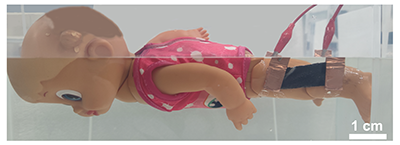Numerous flexible fitness trackers cannot be immersed in water as the wearers would feel uncomfortable wearing the coatings needed to seal these devices.
 An underwater movement sensor attached to a motorized swimming doll’s knee alerts a smartphone app when the doll stops kicking, simulating a swimmer in distress. Image Credit: Adapted from ACS Nano 2022, DOI: 10.1021/acsnano.2c08325
An underwater movement sensor attached to a motorized swimming doll’s knee alerts a smartphone app when the doll stops kicking, simulating a swimmer in distress. Image Credit: Adapted from ACS Nano 2022, DOI: 10.1021/acsnano.2c08325
Scientists have coated a thin, slippery coating on a conductive fabric, forming a breathable underwater movement sensor. They reported their creation in the ACS Nano journal.
The scientists then combined the sensor with a smart device that can wirelessly alert a smartphone app if a swimmer is no longer moving, a warning that they could be drowning.
There are numerous applications for underwater movement sensors, including tracking the activity and safety of swimmers and checking the heart rate. However, existing approaches to shield these electronics make the devices bulky and impervious to air, resulting in skin irritation.
Earlier research has demonstrated that thin, smooth layers of polydimethylsiloxane (PDMS) offer adequate water repulsion to protect flexible movement sensors in water, but it is uncertain whether the coating would offer any comfort to the wearer.
Cheolmin Park, Jianying Huang, Yuekun Lai, and contemporaries were keen to test PDMS as a coating that could repel water for a fabric-based sensor that would be one of the components of a wireless underwater movement detection system.
To achieve this, the scientists immersed a portion of polyester knit fabric into a graphene oxide solution, hydroiodic acid, and a solution comprising PDMS microparticles and nanoparticles.
Preliminary tests revealed that the coated fabric was water-repellent and conductive, yet still pervious to air, signifying that the material would offer wearers the required comfort. When a portion of the coated fabric was fixed to a person’s finger that was then bent while underwater, it generated a quantifiable electrical response.
The researchers integrated the fabric-based sensor with a power supply and a data collector to develop a smart underwater movement system that could wirelessly convey the electrical response to a smartphone app. The app monitored the doll's kicking legs when the smart device was fixed to a mechanical swimming doll.
To mimic a swimmer in trouble, the kicking motion of the doll was switched off, and the app transmitted a red warning message. The scientists say that because the smart movement sensor is water-repellant, it could help track swimmers’ safety and be employed in other versions of underwater sensors.
The researchers are grateful for the funding from the National Natural Science Foundation of China, the Natural Science Foundation of Fujian Province, the 111 Project, the State Key Laboratory of New Textile Materials and Advanced Processing Technologies, the China National Textile and Apparel Council Key Laboratory of Flexible Devices for Intelligent Textile and Apparel, Soochow University, the Natural Science Funds for Distinguished Young Scholars of Fujian Province, and the Creative Materials Discovery Program through the National Research Foundation of Korea (NRF).
Journal Reference
Zhu, T., et al. (2022) A Breathable Knitted Fabric-Based Smart System with Enhanced Superhydrophobicity for Drowning Alarming. ACS Nano. doi.org/10.1021/acsnano.2c08325.